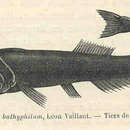en
names in breadcrumbs


Sigmops bathyphilus és una espècie de peix pertanyent a la família dels gonostomàtids.
És un peix marí i batipelàgic[10] que viu entre 700 i 3.000 m de fondària i entre les latituds 66°N-35°S. No fa migracions verticals diàries.[11][6][12]
Es troba a l'Atlàntic oriental (des de 65° 30′ N, 30° 30′ W de latitud fins a Namíbia[13] i Sud-àfrica -Cape Point-), l'Atlàntic nord-occidental (el Canadà),[9] l'Atlàntic occidental central (entre 20°N i 5°S) i l'Atlàntic sud i el Pacífic (tots dos entre 30°S i 35°S).[14][6][15][16][17][18][19][20][21][22][23][24][25][26][27][28][29][30][31]
És inofensiu per als humans.[6]
Sigmops bathyphilus és una espècie de peix pertanyent a la família dels gonostomàtids.
Sigmops bathyphilus, commonly called the spark anglemouth, deepsea fangjaw or deepsea lightfish,[3] is a species of fish in the family Gonostomatidae (anglemouths).[4]

Sigmops bathyphilus is black in colour, with a maximum length of 20 cm (7.9 in) for the female and 15 cm (5.9 in) for the male. It has 11–15 dorsal soft rays and 22–26 anal soft rays.[5] It has very small photophores.[6] It has a few enlarged teeth on the roof of the mouth.[7]
Sigmops bathyphilus lives in the Atlantic Ocean, southern Indian Ocean, off the south coast of Australia and South Pacific Ocean.[8] It is bathypelagic, living at depths of 700–3,000 m (2,300–9,800 ft), hence its specific name, from Greek words meaning "depth-loving".[5][9]
Sigmops bathyphilus undergoes sex reversal (from male to female) at a length of 5–10 cm (2.0–3.9 in), with females spawning once they reach 11 cm (4.3 in). Some individuals are "super males", who do not change sex and are the principal spawners.[5][10]
Sigmops bathyphilus, commonly called the spark anglemouth, deepsea fangjaw or deepsea lightfish, is a species of fish in the family Gonostomatidae (anglemouths).
Sigmops bathyphilum es una especie de pez,[1][2] de la familia de los gonostomátidos o peces luminosos.[3]
Su nombre científico deriva del griego sigma (la letra S) y bathyphilum (preferencia por las profundidades).[4]
Su longitud máxima descrita ha sido de 15 cm los machos y 20 cm las hembras.[1] No tiene espinas en las aletas dorsal ni anal, con radios blandos alrededor de una docena en la aleta dorsal y docena y media en la aleta anal.[1] Tiene color totalmente negro.[5] Posee unos pocos dientes agrandados en el techo de la boca, con pocos radios en la aleta anal y numerosas espinas branquiales, cuerpo comprimido y fotóforos extremadamente pequeños.[6]
Es un pez marino oceánico batipelágico no migrador de aguas profundas, que habita en un rango de profundidad entre los 700 y 3000 metros.[7] Se distribuye ampliamente por el océano Atlántico, mar Caribe, océano Pacífico y océano Índico, en aguas templadas y tropicales, entre los 66º de latidud norte y los 35º de latitud sur.[1]
Es una especie batipelágica,[8] con una clara estratificación de tamaños con la profundidad y no hay migraciones verticales diarias.[1] Comienzan a desarrollar los fotóforos cuando alcanzan un tamaño de 1'1 cm.[1] Se alimenta de crustáceos.[8]
Cambian de sexo cuando alcanzan entre 5 y 10 cm de tamaño,[1] pero algunos machos se convierten en súper-machos, al parecer, no sometidos a reversión sexual y son los reproductores principales.[1] Las hembras comienzan a desovar a partir de 11 cm de tamaño.[1] Los machos tienen el sentido del olfato muy desarrollado, al contrario que las hembras.[1]
Sigmops bathyphilum es una especie de pez, de la familia de los gonostomátidos o peces luminosos.
Su nombre científico deriva del griego sigma (la letra S) y bathyphilum (preferencia por las profundidades).
Sigmops bathyphilus Sigmops generoko animalia da. Arrainen barruko Gonostomatidae familian sailkatzen da.
Sigmops bathyphilus Sigmops generoko animalia da. Arrainen barruko Gonostomatidae familian sailkatzen da.
Gonostoma bathyphilum est une espèce de poissons téléostéens.
Sigmops bathyphilus is een straalvinnige vissensoort uit de familie van de borstelmondvissen (Gonostomatidae).[1] De wetenschappelijke naam van de soort is voor het eerst geldig gepubliceerd in 1884 door Vaillant.
Bronnen, noten en/of referenties